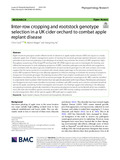JavaScript is disabled for your browser. Some features of this site may not work without it.
| dc.contributor.author | Cook, Chris | |
| dc.contributor.author | Magan, Naresh | |
| dc.contributor.author | Xu, Xiangming | |
| dc.date.accessioned | 2023-07-12T10:09:33Z | |
| dc.date.available | 2023-07-12T10:09:33Z | |
| dc.date.issued | 2023-07-04 | |
| dc.identifier.citation | Cook C, Magan N, Xu X. (2023) Inter-row cropping and rootstock genotype selection in a UK cider orchard to combat apple replant disease, Phytopathology Research, Volume 5, July 2023, Article Number 28 | en_UK |
| dc.identifier.issn | 2096-5362 | |
| dc.identifier.uri | https://doi.org/10.1186/s42483-023-00184-y | |
| dc.identifier.uri | https://dspace.lib.cranfield.ac.uk/handle/1826/19961 | |
| dc.description.abstract | Apple rootstock genotypes confer different levels of tolerance to apple replant disease (ARD) and vigour to a newly replanted apple tree. A hybrid management system of rotating the rootstock genotype planted between successive generations and inter-row planting in the alleyways of orchards may minimise the severity of ARD symptoms. High-throughput sequencing of the fungal ITS and bacterial 16S rDNA regions was used to investigate the diversity, and differential taxa present in soils displaying symptoms of ARD. Candidate pathogens and beneficial microorganisms were correlated with the above-ground establishment of each rootstock genotype in a UK cider orchard. Our results suggest that the same rootstock or rootstock with closely related parentage to the previous rootstock had more severe ARD symptoms. Planting in the alleyway appeared an effective strategy to minimise the severity of symptoms irrespective of rootstock genotype. The planting location effect had a higher contribution to the variation in the rhizosphere microbiome than that of the rootstock genotype. No predicted causal agents for ARD could be identified to a taxonomic level to predict their function but two species associated with mycorrhizae, Pteridiospora spinosispora and Paraglomus laccatum were identified as inversely correlated with ARD severity and could be candidate beneficial species for apple, warranting further investigation and research. Our findings suggest that planting in the alleyways and planting rootstocks genetically dissimilar to the previously planted rootstock can be beneficial for tree establishment. We have also identified species inversely associated with ARD severity, making candidates for future research to test the antagonistic effect of the species against ARD pathogens in apple roots. | en_UK |
| dc.description.sponsorship | Biotechnology and Biological Sciences Research Council (BBSRC): BB/M01777X/1. HEINEKEN UK Limited, Frank P. Matthews, Fruittree Rootstock Holland B.V., Vermeerderingstuinen Nederland, A.C. Goatham & Son | en_UK |
| dc.language.iso | en | en_UK |
| dc.publisher | BioMed Central | en_UK |
| dc.rights | Attribution 4.0 International | * |
| dc.rights.uri | http://creativecommons.org/licenses/by/4.0/ | * |
| dc.subject | Apple replant disease | en_UK |
| dc.subject | Rootstock soil rhizosphere | en_UK |
| dc.subject | Microbiome | en_UK |
| dc.title | Inter-row cropping and rootstock genotype selection in a UK cider orchard to combat apple replant disease | en_UK |
| dc.type | Article | en_UK |
| dc.identifier.eissn | 2524-4167 |
Files in this item
The following license files are associated with this item:
This item appears in the following Collection(s)
-
Staff publications (SWEE) [2852]

